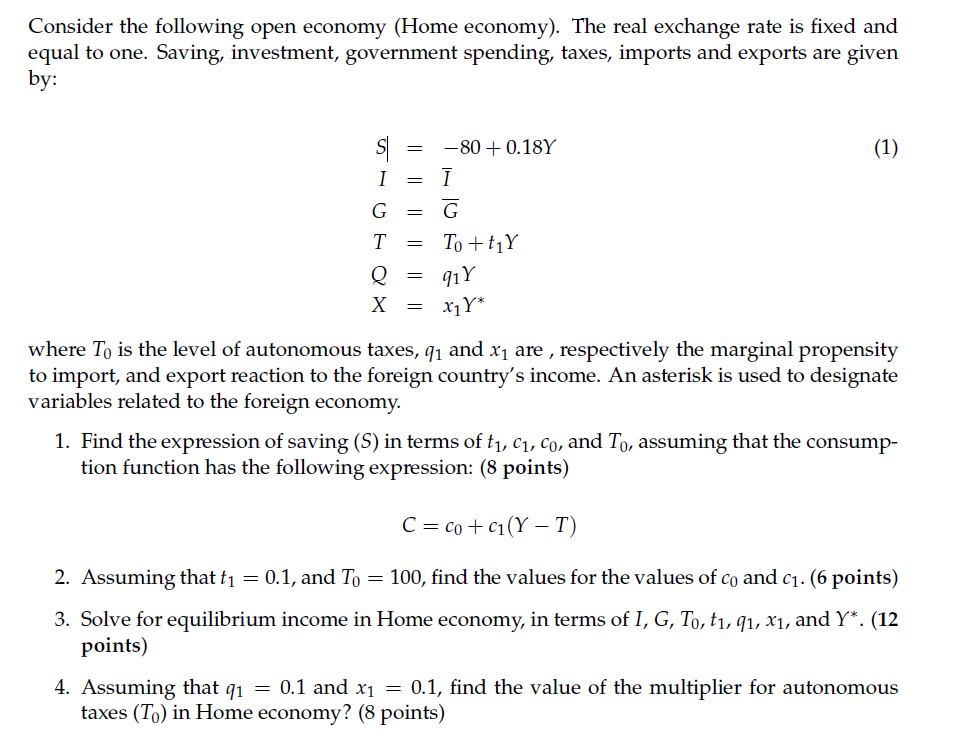Answered step by step
Verified Expert Solution
Question
1 Approved Answer
please answer question 7(b), thank you Consider the following open economy (Home economy). The real exchange rate is fixed and equal to one. Saving, investment,




please answer question 7(b), thank you
Consider the following open economy (Home economy). The real exchange rate is fixed and equal to one. Saving, investment, government spending, taxes, imports and exports are given by: = -80+ 0.18Y (1) I G G = T = To+tY Q = 91Y xY* X = where To is the level of autonomous taxes, q and x are, respectively the marginal propensity to import, and export reaction to the foreign country's income. An asterisk is used to designate variables related to the foreign economy. 1. Find the expression of saving (S) in terms of t, C, Co, and T, assuming that the consump- tion function has the following expression: (8 points) C=c+c1(Y T) 2. Assuming that t = 0.1, and To = 100, find the values for the values of co and c. (6 points) 3. Solve for equilibrium income in Home economy, in terms of I, G, To, t, 91, x, and Y*. (12 points) 4. Assuming that q = 0.1 and x = 0.1, find the value of the multiplier for autonomous taxes (To) in Home economy? (8 points) 5. Assume Foreign economy has the same equations as Home economy. Moreover, use the following values for the remaining autonomous variables: I = 500, G = 500. (a) Solve for the equilibrium values of income, Y, and Y* in both economies. (8 points) (b) Find the tax multiplier for each economy now? (8 points) (c) Why is it different from the multiplier found above using the given values for the autonomous variables? (8 points) (d) Find the equilibrium values for government and trade deficits in each economy. (8 points) 6. Assume Home economy wants to increase GDP by 150. (a) What is the necessary change in the level of autonomous taxes, ATo, assuming that Foreign economy does not change its spending or its autonomous tax level to achieve the target output? (8 points) (b) Solve for net exports and the budget deficit in each economy. How do they compare to the values found in (5)? If there is any difference, discuss it. (10 points) 7. Assume now that both countries want to achieve the same increase in their GDP. They want to coordinate changes in their levels of autonomous taxes to achieve the target out- put. (a) Find the required change in autonomous taxes in each economy. (6 points) (b) Solve for net exports and the budget deficit in each economy. How do they compare to the values found in (6)? Discuss the difference if there is any. (10 points) Consider the following open economy (Home economy). The real exchange rate is fixed and equal to one. Saving, investment, government spending, taxes, imports and exports are given by: = -80+ 0.18Y (1) I G G = T = To+tY Q = 91Y xY* X = where To is the level of autonomous taxes, q and x are, respectively the marginal propensity to import, and export reaction to the foreign country's income. An asterisk is used to designate variables related to the foreign economy. 1. Find the expression of saving (S) in terms of t, C, Co, and T, assuming that the consump- tion function has the following expression: (8 points) C=c+c1(Y T) 2. Assuming that t = 0.1, and To = 100, find the values for the values of co and c. (6 points) 3. Solve for equilibrium income in Home economy, in terms of I, G, To, t, 91, x, and Y*. (12 points) 4. Assuming that q = 0.1 and x = 0.1, find the value of the multiplier for autonomous taxes (To) in Home economy? (8 points) 5. Assume Foreign economy has the same equations as Home economy. Moreover, use the following values for the remaining autonomous variables: I = 500, G = 500. (a) Solve for the equilibrium values of income, Y, and Y* in both economies. (8 points) (b) Find the tax multiplier for each economy now? (8 points) (c) Why is it different from the multiplier found above using the given values for the autonomous variables? (8 points) (d) Find the equilibrium values for government and trade deficits in each economy. (8 points) 6. Assume Home economy wants to increase GDP by 150. (a) What is the necessary change in the level of autonomous taxes, ATo, assuming that Foreign economy does not change its spending or its autonomous tax level to achieve the target output? (8 points) (b) Solve for net exports and the budget deficit in each economy. How do they compare to the values found in (5)? If there is any difference, discuss it. (10 points) 7. Assume now that both countries want to achieve the same increase in their GDP. They want to coordinate changes in their levels of autonomous taxes to achieve the target out- put. (a) Find the required change in autonomous taxes in each economy. (6 points) (b) Solve for net exports and the budget deficit in each economy. How do they compare to the values found in (6)? Discuss the difference if there is any. (10 points)Step by Step Solution
There are 3 Steps involved in it
Step: 1

Get Instant Access to Expert-Tailored Solutions
See step-by-step solutions with expert insights and AI powered tools for academic success
Step: 2

Step: 3

Ace Your Homework with AI
Get the answers you need in no time with our AI-driven, step-by-step assistance
Get Started


